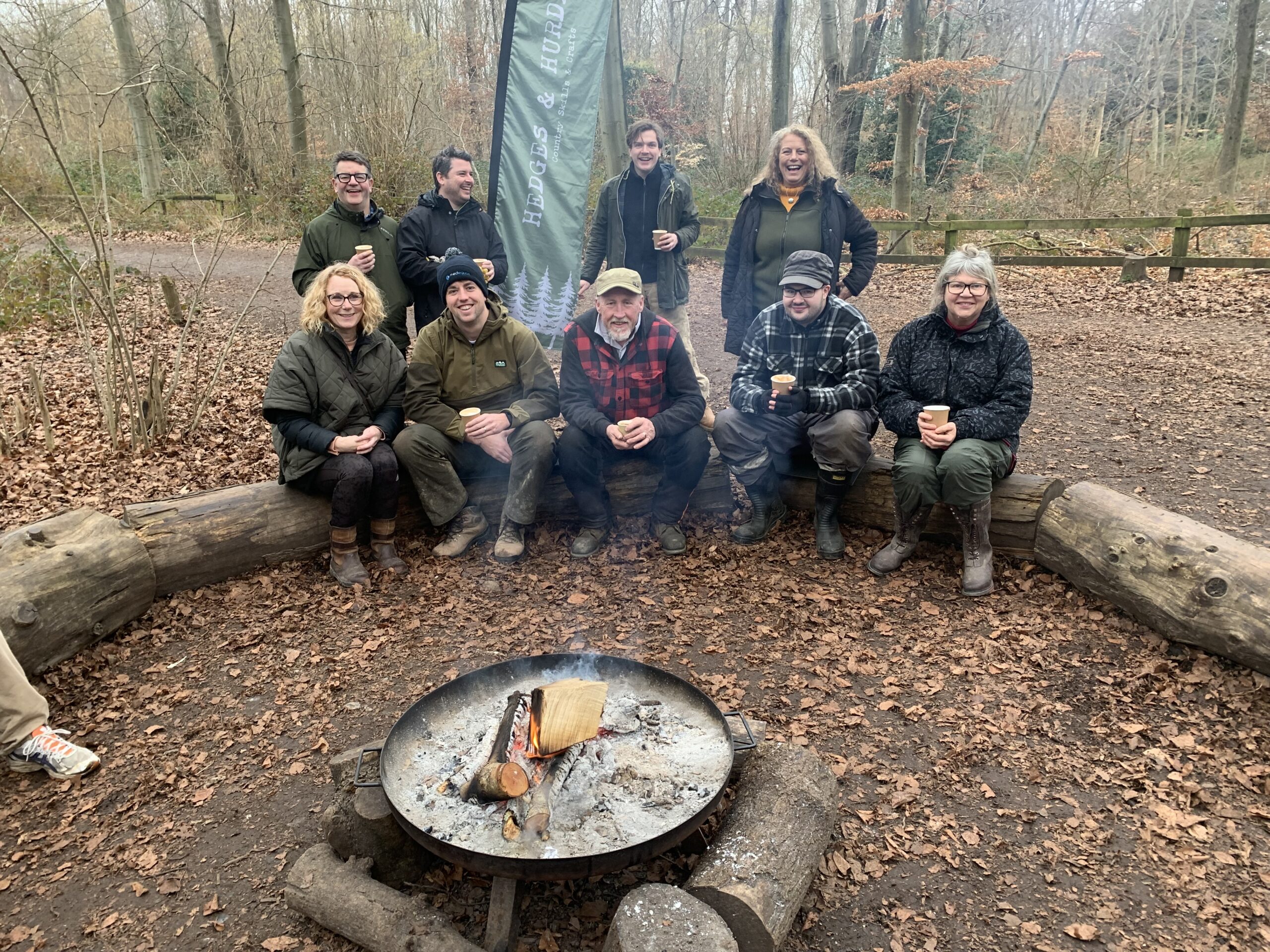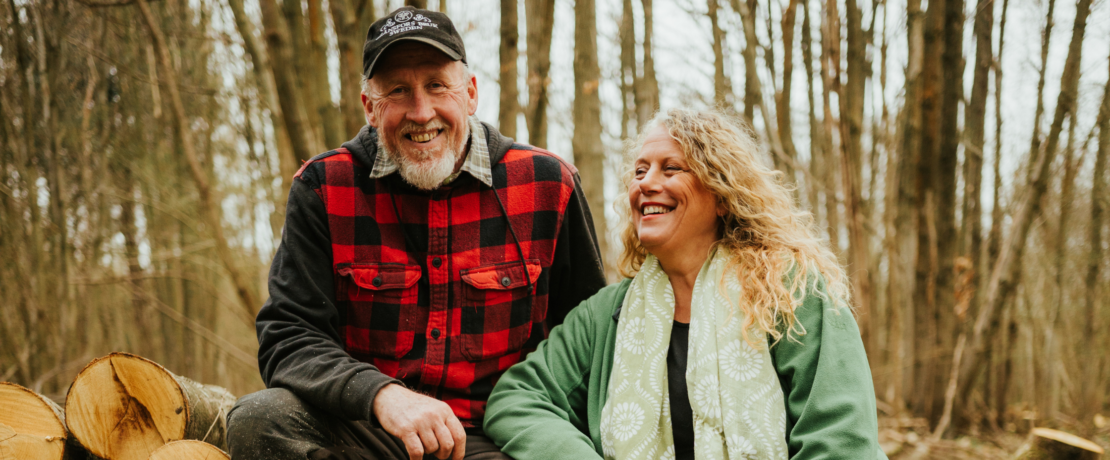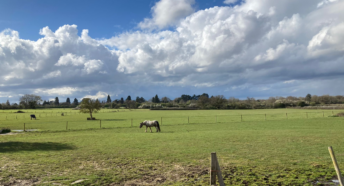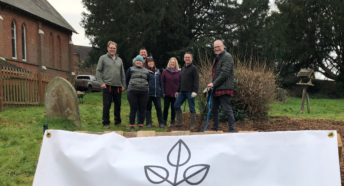Surrey Countryside Champions – Hedges and Hurdles
Award-winning hedgelaying champion and experienced horticulturist Paul Matthews started Hedges and Hurdles in 2000, offering Hedgelaying commercially. Lorraine Ellery Matthews joined him in 2018 to develop their workshops and training courses further.
Recent years have seen a rise in interest in reconnecting with the natural world and Paul and Lorraine’s workshops are the perfect way to do this. We spoke to Lorraine to find out more about the work they do.
1. Thank you for taking the time to talk to us. Please can you summarise who you are and what you do?
Hedgelaying is a management solution for overgrown hedges widely practised throughout the UK and Europe. Paul is an experienced tutor, five times national award-winning hedgelaying champion and an experienced horticulturist.
I changed from a career in the scholarly publishing industry to becoming skilled at making handmade crafts from wood I coppice and harvest locally, specialising in Willow art and craft. I combine these new skills with my commercial experience to deliver personable, varied, and interesting workshops and training courses for all.
The “Experiences” we offer include Hedgelaying, Coppicing and Wattle Hurdle Making training courses through to hands-on Wood Craft and Willow Art, Craft & Sculpture workshops delivered at various locations across the Surrey Hills & Sussex throughout the year.

2. How did Hedges & Hurdles come about?
Inspired by hedgelayers he had watched working when out in the countryside with his Grandfather when young, Paul began learning the art of hedgelaying. He started the business under the name of Hedges & Hurdles in 2000 and began offering hedgelaying on a commercial basis. I made a huge career change to join Paul in 2018 to take the business to the next level, rebranding to Hedges & Hurdles Country Skills & Crafts and developing our training courses and workshops. I’ve never looked back.
3. How does the work you do support the Surrey countryside?
Hedgelaying is a traditional country craft that rejuvenates existing hedgerows by encouraging them to put on new growth. It improves the overall structure and strength of a hedge providing protection for crops and wildlife.
A hedge that has been correctly managed will provide a healthy habitat for wildlife compared to a hedge that has either overgrown, collapsed or has been overmanned by hard trimming annually. When this happens the potential for the hedge to flower and produce fruit is diminished and eventually, the hedge will degrade and become hollow at the base.
Hedgelaying rejuvenates the hedge. Healthy hedges can offer a solution to help fight climate change as they sequester carbon both in woody growth above the ground and in their roots, leaf litter and soil below ground. In addition, hedges across slopes capture eroding soil and can increase soil organic carbon for up to 60m uphill.
Hedgerows provide refuge and corridors for wildlife to enable movement throughout the landscape and offer an important source of food for birds and small mammals.
Field mice, voles, hedgehogs, snakes, and other small mammals will all benefit from the abundance of berries produced by the hedgerow trees and use this and the surrounding habitat as breeding sites. Healthy hedgerows also provide nesting sites and song posts for a wide variety of birds. The base of a hedge and its associated field margins, banks and ditches support a wide variety of insects including Bumblebees.
If maintained, a living hedge and the trees within the hedgerow can remain in situ for hundreds of years and continue to offer these benefits.

4. Sustainability is clearly important to you. How do you make sure your business is as sustainable as possible?
We pride ourselves in using natural materials for the heritage skills we teach and crafts we make. Most of our materials are coppiced and cut locally by ourselves as part of a sustainable woodland management programme. Paul has managed a large area of Sweet Chestnut and Hazel Coppice for over 25 years at Norbury Park, Dorking using these materials to make stakes and binders for hedging. I pollard and coppice Willow to make plant supports and wreaths from various locations including the Birtley Estate in Bramley.
Apart from wire and twine, we do not use any other types of material in our courses. The majority of tools we use are vintage too, Paul prefers to have a tool re-handled rather than replaced with a new one and is always on the lookout for bargains and collectors’ items on eBay! He really does care about his tools, the first thing he does when he comes home is to start sharpening them ready for their next use.
I manage the administration side of the business from our home office. We limit any printing but for anything we do print we use recycled materials. Sustainability and locality is always at the forefront of our minds when sourcing new suppliers or working with collaborative partners.
As long-standing members of Surrey Hills Enterprises, we have been awarded the Trade Mark Surrey Hills, an accreditation and a Mark of local provenance and quality. The Award promotes the very best of what Surrey has to offer and celebrates those organisations of high quality that reflect and support the distinct and special nature of The Surrey Hills and who share the values of supporting the local environment.
5. Hedgerows are such an important part of our landscape, how can people ensure they are looked after and protected?
If you are a landowner or manager then we cannot stress enough how important it is not to overmanage your hedgerows. We have already mentioned the benefits of a healthy hedgerow and encourage you to review how often you cut your hedges. Some do this once a year when it is more beneficial to leave a gap of at least 1 year before cutting the top of the hedge. An overmanaged hedge and a poorly flayed hedge not only looks unattractive, but it is damaging the hedgerow too.
It’s great when people or organisations are actively planting new trees, which is an important part of addressing climate change. However, I personally believe it is more pressing to ensure our existing hedgerows are maintained properly, they after all already sequester and store a huge amount of carbon which will take many years for new trees to capture.
6. Country skills and woodcraft, like those taught in your workshops, seem to be gaining popularity again. Why do you think this is?
I think, given the past few years, people are more aware of the importance of finding time for themselves and their loved ones and looking after their health too. Our courses promote wellness, getting outside is great for our mental health and rhythmic exercise and activities have a calming effect on us especially when also surrounded by beautiful countryside or picturesque gardens.
The physiological effects of exercise, such as reducing blood pressure and increasing heart rate, also help to reduce levels of the stress hormone cortisol. At all ages, people who adventure outside have been found to have higher levels of self-esteem and feel that they can cope better with the stresses of modern life.
From a hedgelaying training point of view, we are providing courses that can enable a trainee to progress their skills. As an accredited member and preferred training provider for the National Hedgelaying Society (NHLS) we not only offer introductions to Hedgelaying for those that wish to enjoy a new experience but the opportunity for individuals to progress to a Hedgelaying Skills Training course and assessment leading to a NHLS Lantra Accreditation at Bronze, Silver or Gold level. Providing training and assessments gives the opportunity for people to improve and develop their skills so they can then use the knowledge gained in their everyday work, be it as a volunteer for organisations such as Surrey Wildlife Trust or as a landowner looking to improve his own hedgerows. It’s also equally as important to be able to pass on these skills to the next generation of professional hedgelayers.
There are lots of benefits to getting outside, however, the smiles on people’s faces and the feedback we get following one of our experiences just says it all!
7. How can people and Surrey residents support Hedges and Hurdles?
We are only a very small business but are involved in lots of different projects. We often reach out for the support from volunteers, therefore, if you wish to help us with some of our activities during busy periods then do get in touch.
8. Your team does amazing work. When you take a break what’s your favourite Surrey greenspace to explore?
As owners of two energetic dogs, we take every opportunity to explore the Surrey countryside whenever we can. We are so lucky to have so many greenspaces in this county and they are all so different. As we run so many of our courses at Norbury Park and the dogs come with us this has to be the place we have explored and love the most. We are also members of the Norbury Park Community forum so have an opportunity to be part of the conversation regarding its management. Surrey Wildlife Trust manages the site for biodiversity and ecosystem conservation purposes and Surrey County Council manages all other aspects, including public access, land protection, visitor services and infrastructure maintenance.
Another favourite is Leith Hill. This is our walk of choice on New Year’s day each year, followed by a visit to a local pub garden for a pint (or in my case a half a shandy) and a bowl of chips!
You can find out more about Hedges and Hurdles on their website or give them a follow on Instagram @hedgesandhurdles.









